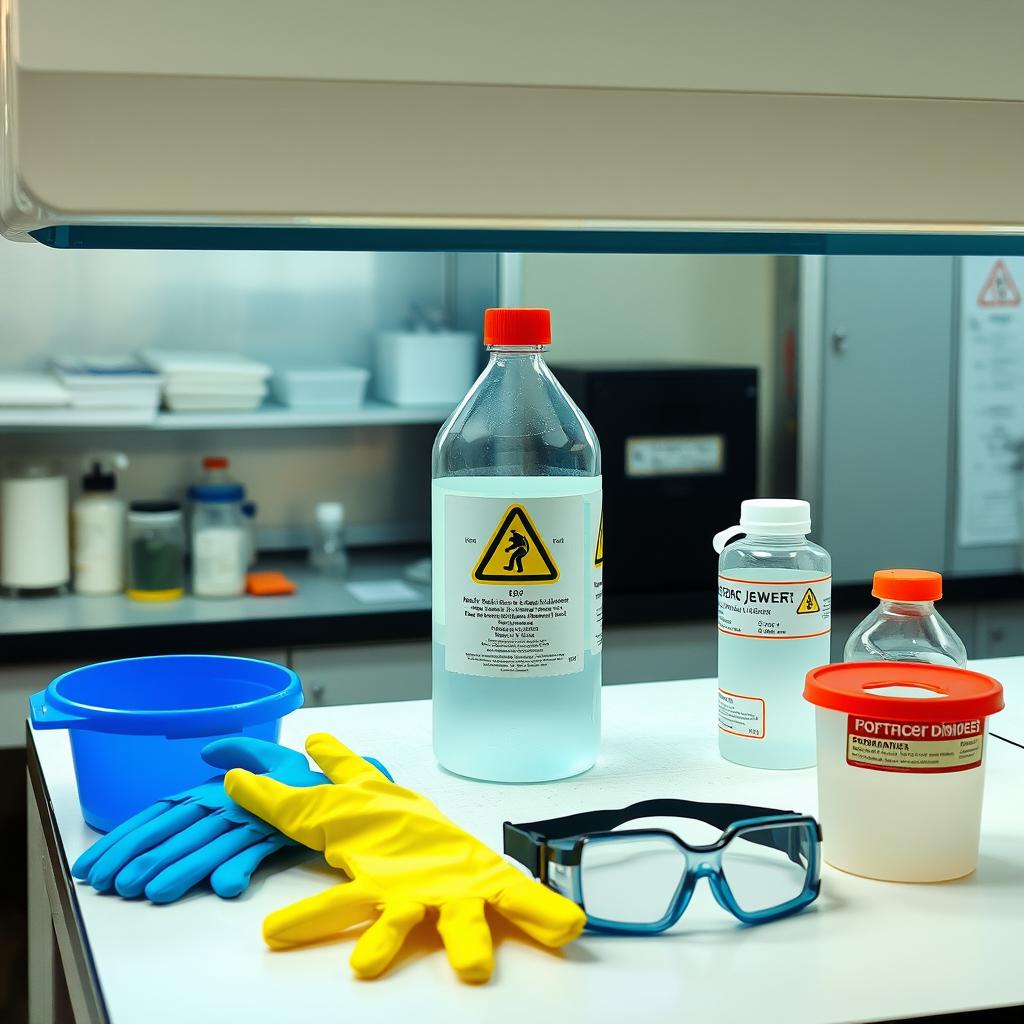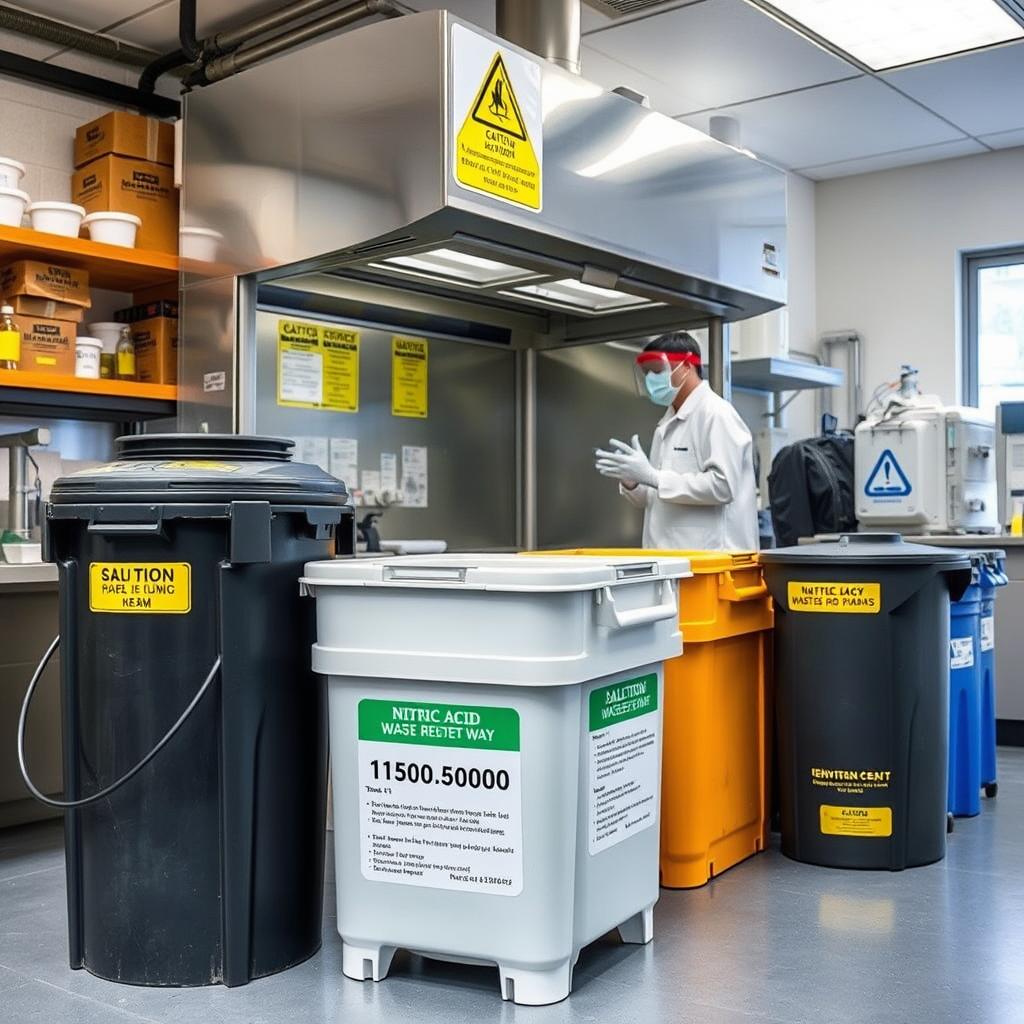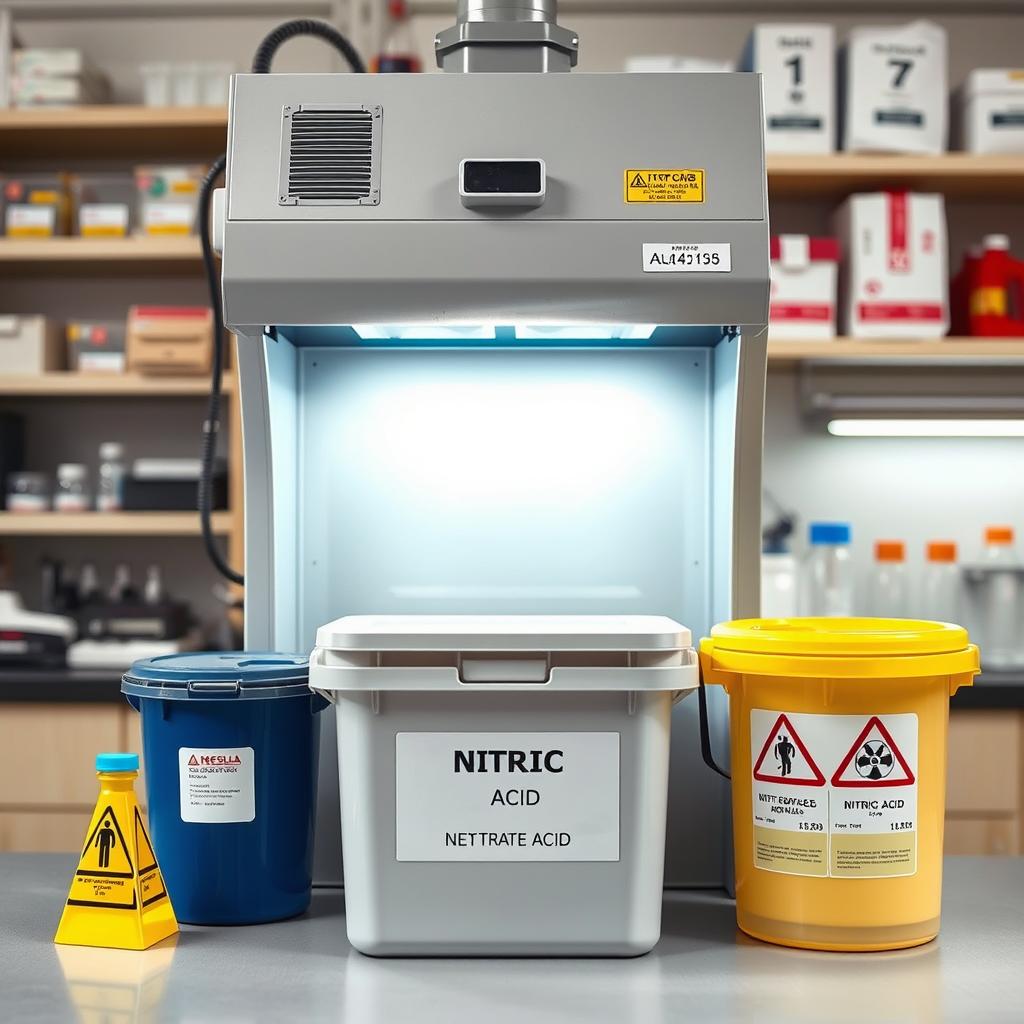Handling hazardous materials like nitric acid comes with big risks if not disposed of right. The big question is: what’s the safest way to get rid of nitric acid? Knowing how to dispose of it safely is vital for keeping our environment and health safe. It’s something everyone who works with this chemical needs to learn. Getting rid of nitric acid safely needs careful planning and action. We aim to give a detailed guide on how to do it right. By following these steps, we can all help keep our environment safe from nitric acid’s harm.
Click to use Silverigroup personal shopper services
Key Takeaways:
- Understanding the hazards of nitric acid is crucial for safe disposal
- Proper storage and handling are essential before disposal
- Neutralization and dilution methods are important for safe disposal
- Professional disposal services may be necessary for large quantities
- Environmental considerations must be taken into account during disposal
- Following regulatory guidelines is essential for compliance
- Record keeping and documentation are critical for tracking disposal
Understanding the Hazards of Nitric Acid
Nitric acid is very corrosive and toxic. It needs careful handling and disposal. Knowing its chemical properties and risks is key. Managing nitric acid waste involves several steps. These include storage, transport, and disposal. It’s crucial to follow strict guidelines and regulations. The Environmental Protection Agency (EPA) has set rules for handling and disposing of nitric acid safely.
Chemical Properties and Risks
Nitric acid is very reactive and can explode if mishandled. Understanding its properties and risks is vital. It’s a strong acid that can cause severe burns and respiratory issues.
Click to buy citric acid from Silvairgroup
Health and Environmental Impact
Improper handling and disposal of nitric acid can harm health and the environment. It can lead to respiratory problems, skin burns, and eye damage. It also contaminates soil, water, and air.
Legal Requirements for Handling
There are strict laws for handling nitric acid. The Occupational Safety and Health Administration (OSHA) and the EPA have guidelines. It’s important to follow these to handle and dispose of nitric acid safely and legally.
Some key legal requirements for managing nitric acid include:
- Proper storage and labeling of nitric acid
- Use of personal protective equipment (PPE) when handling nitric acid
- Implementation of emergency response plans in case of spills or accidents
- Compliance with EPA regulations for disposal of nitric acid

Essential Safety Equipment for Nitric Acid Disposal
Handling nitric acid requires the right safety gear to avoid accidents and ensure safe nitric acid disposal methods. This includes personal protective equipment (PPE) like gloves, goggles, and masks. Here’s what you need for a safe work area:
- Gloves: to prevent skin contact with nitric acid
- Goggles: to protect the eyes from splashes
- Respiratory protection: to prevent inhalation of fumes
Click to buy frozen a grade beluga fish from Silverigroup
Also, having emergency gear like spill kits and fire extinguishers is key. They help quickly handle any accidents during safe nitric acid disposal methods. With the right safety equipment and following proper steps, you can lower the risks of handling nitric acid. This ensures a safe and effective disposal process.
Proper Storage Before Disposal
When dealing with proper nitric acid disposal, storing it safely is key. Before getting rid of nitric acid, it must be kept in a secure place. This helps avoid accidents and protects the environment. To store nitric acid safely, follow some important steps. Use containers that fit well and have tight lids. Keep the acid in areas with good air flow. Also, make sure it’s not near things that could react badly with it.
Container Requirements
The containers for nitric acid must be safe for it. This means they should be made of glass or certain plastics. They also need tight lids to stop spills and leaks.
Storage Conditions
Store nitric acid in a cool, dry spot. It should be in a place with good air flow, away from sunlight and heat. Make sure there’s equipment ready for spills and a fire extinguisher nearby.
Labeling Guidelines
Containers with nitric acid need clear labels. They should show what’s inside, how strong it is, and any dangers. This helps everyone handle and dispose of it safely. By following these steps for proper nitric acid disposal, you can lower risks. Remember, safe storage is a big part of getting rid of nitric acid right. Ignoring this can lead to serious problems.
- Using compatible containers with tight-sealing lids
- Storing the acid in a well-ventilated area
- Keeping the acid away from incompatible materials
- Labeling containers clearly with contents and hazard warnings
By being careful, you can keep nitric acid safe before you dispose of it. This reduces the chance of accidents and harm to the environment.

Disposing of nitric acid safely needs careful planning and action. Best practices for nitric acid disposal include neutralization, dilution, and using professional services. It’s vital to follow these steps to protect health and the environment. Neutralizing nitric acid is a key step. This means mixing it with a base to create a neutral solution. Here are some common ways to do this:
- Using sodium hydroxide or calcium hydroxide to neutralize the acid
- Employing a neutralization tank with a built-in pH monitoring system
- Utilizing a chemical neutralization kit specifically designed for nitric acid
Diluting nitric acid is another safe disposal method. This involves mixing it with water to lower its concentration. But, it’s important to do this correctly to avoid accidents. For big amounts of nitric acid, getting professional disposal services is best. They have the right tools and know-how to handle it safely. By sticking to these steps and best practices for nitric acid disposal, you can dispose of it safely and responsibly.
Environmental Considerations During Disposal
Managing nitric acid waste is key to protecting our environment. The way we dispose of nitric acid affects our water and soil. This can harm both our ecosystems and our health. To keep our environment safe, we need good waste management plans. This means storing, handling, and disposing of nitric acid carefully. We also need to prevent accidents and spills. Important steps for protecting the environment include:
- Using compatible storage containers to prevent leakage and contamination
- Implementing spill response plans to quickly respond to accidents
- Disposing of nitric acid through licensed facilities that follow environmental regulations
By focusing on environmental safety during disposal, we can reduce risks. This helps protect our planet for the future.

Managing nitric acid waste well requires a big-picture approach. We must consider how disposal affects the environment. Working together, we can make our environment safer and more sustainable.
| Environmental Consideration | Measure to Mitigate Risk |
|---|---|
| Water Contamination | Use of compatible storage containers and spill response plans |
| Soil Contamination | Proper disposal of nitric acid through licensed facilities |
| Air Pollution | Implementation of ventilation systems and emission controls |
Common Mistakes to Avoid in Nitric Acid Handling
Handling nitric acid needs careful safety steps to avoid accidents and harm to the environment. Knowing how to safely dispose of nitric acid is key. This includes avoiding common mistakes that can lead to dangerous situations. Some common errors include using the wrong containers, mixing with the wrong materials, and poor ventilation. These can be fixed by following safety rules and using the right tools for handling nitric acid. For example, using containers that won’t corrode from nitric acid is very important for safe storage and transport. To make sure nitric acid is disposed of properly, remember these points:
- Always use containers that are safe for storing nitric acid.
- Don’t mix nitric acid with other substances that could react badly.
- Make sure the area is well-ventilated to prevent harmful fumes from building up.
By being careful and taking the right steps, we can avoid accidents and protect the environment. This ensures that nitric acid is disposed of safely.
| Mistake | Prevention |
|---|---|
| Improper container usage | Use containers resistant to nitric acid corrosion |
| Mixing with incompatible materials | Follow compatibility charts for safe mixing |
| Ventilation errors | Ensure good ventilation to prevent fume accumulation |

Emergency Procedures and Spill Management
In case of a nitric acid spill, having a solid emergency plan is key. It ensures safe handling and disposal of nitric acid. This plan includes evacuation, containment, and cleanup steps to protect people and the environment.
A good emergency plan should outline immediate actions after a spill. It should cover:
- Evacuating the area to avoid nitric acid exposure
- Stopping the spill from spreading
- Neutralizing the acid to lessen its damage
- Proper cleanup and disposal following handling and disposal of nitric acid rules
It’s also vital to have the right safety gear ready. This includes gloves, goggles, and masks to protect responders from nitric acid’s dangers. Being ready and having a detailed emergency plan helps ensure a safe response to nitric acid spills. It reduces risks and ensures proper handling and disposal of nitric acid.
| Emergency Procedure | Description |
|---|---|
| Evacuation | Quickly moving people away from the spill area |
| Containment | Using barriers or absorbents to stop the spill from spreading |
| Cleanup | Removing and disposing of spilled nitric acid and affected materials |
Documentation and Compliance Requirements
Proper guidelines are key for safe nitric acid disposal. Laws and regulations govern how to dispose of nitric acid. It’s important to keep accurate records and follow these rules. This includes tracking the amount, disposal method, and location. Nitric acid disposal guidelines state that all transport must be documented and follow laws. You need the right permits and must package and label correctly. Not following these rules can lead to fines and penalties.
Record Keeping
Keeping records is crucial for nitric acid disposal. You need to track the amount, disposal method, and location. These records must be kept for a certain time and available to authorities if asked.
Regulatory Guidelines
Regulations for nitric acid disposal vary by location. But most aim to protect the environment and human health. You must use approved disposal methods, like neutralization, and follow local guidelines.
Transportation Documentation
Transporting nitric acid requires specific documents. You need permits and to follow packaging and labeling rules. Here are some important documents:
- Shipping papers
- Bill of lading
- Certificate of analysis
- Material safety data sheet
By following these guidelines and keeping accurate records, you ensure safe and compliant disposal. Always adhere to nitric acid disposal guidelines to protect the environment and human health.
Conclusion
Properly getting rid of nitric acid is very important. It involves knowing the dangers, wearing the right safety gear, and following the rules. This way, people and companies can handle nitric acid safely.
It’s also wise to call in the experts for the final steps. This makes sure you follow local laws and keeps the environment safe. To dispose of nitric acid right, you need to be well-informed and ready. Following the advice in this article helps keep everyone and the planet safe. Remember, handling nitric acid safely is a big deal.
FAQ: How to dispose of nitric acid
What are the proper methods for disposing of nitric acid?
Safe ways to get rid of nitric acid include neutralization, dilution, and using professional services. Always follow safety rules to protect health and the environment.
What safety equipment is needed when handling nitric acid?
When working with nitric acid, you need the right gear. This includes gloves, goggles, and a respirator or fume hood. Also, keep emergency items like spill kits and fire extinguishers ready.
How should nitric acid be stored before disposal?
Store nitric acid in a well-ventilated area. Use a compatible container with a tight lid. Keep it away from harmful materials and label the containers clearly.
What are the environmental considerations for nitric acid disposal?
Nitric acid can harm the environment if not disposed of right. It can pollute water and soil. So, it’s key to protect ecosystems during disposal.
What are the common mistakes to avoid when handling nitric acid?
Avoid using the wrong containers and mixing it with harmful materials. Also, don’t forget to ventilate well. Training and following safety rules are crucial.
What should be done in the event of a nitric acid spill?
If there’s a spill, evacuate the area and clean it up fast. Have a plan for emergencies and follow the right steps for spill management.
What documentation and compliance requirements are involved in nitric acid disposal?
Disposing of nitric acid means keeping accurate records and following rules. Make sure all transport is documented and meets legal standards.

